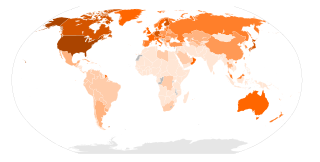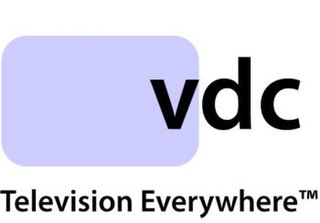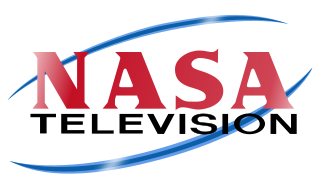A television broadcaster or television network or is a telecommunications network for distribution of television content, where a central operation provides programming to many television stations, pay television providers or, in the United States, multichannel video programming distributors. Until the mid-1980s, broadcast programming on television in most countries of the world was dominated by a small number of terrestrial networks. Many early television networks such as the BBC, CBS, NBC or ABC in the USA and in Australia evolved from earlier radio networks.
TVO, formerly known as TVOntario, is a publicly funded English-language educational television network and media organization serving the Canadian province of Ontario. It operates flagship station CICA-DT in Toronto, which also relays programming across portions of Ontario through eight rebroadcast stations. All pay television providers throughout Ontario are required to carry TVO on their basic tier, and programming can be streamed for free online within Canada.

Television is one of the major mass media outlets in the United States. As of 2011, household ownership of television sets in the country is 96.7%, with approximately 114,200,000 American households owning at least one television set as of August 2013. The majority of households have more than one set. The peak ownership percentage of households with at least one television set occurred during the 1996–97 season, with 98.4% ownership. In 1948, 1 percent of U.S. households owned at least one television while 75 percent did by 1955, and by 1992, 60 percent of all U.S. households received cable television subscriptions.
Pay television, also known as subscription television, premium television or, when referring to an individual service, a premium channel, refers to subscription-based television services, usually provided by multichannel television providers, but also increasingly via digital terrestrial and streaming television. In the United States, subscription television began in the late 1970s and early 1980s in the form of encrypted analog over-the-air broadcast television which could be decrypted with special equipment. The concept rapidly expanded through the multi-channel transition and into the post-network era. Other parts of the world beyond the United States, such as France and Latin America have also offered encrypted analog terrestrial signals available for subscription.
Free-to-air (FTA) services are television (TV) and radio services broadcast in unencrypted form, allowing any person with the appropriate receiving equipment to receive the signal and view or listen to the content without requiring a subscription, other ongoing cost, or one-off fee. In the traditional sense, this is carried on terrestrial radio signals and received with an antenna.
In cable television, governments apply a must-carry regulation stating that locally licensed television stations must be carried on a cable provider's system.
Datacasting is the broadcasting of data over a wide area via radio waves. It most often refers to supplemental information sent by television stations along with digital terrestrial television (DTT), but may also be applied to digital signals on analog TV or radio. It generally does not apply to data which is inherent to the medium, such as PSIP data which defines virtual channels for DTT or direct broadcast satellite systems; or to things like cable modem or satellite modem, which use a completely separate channel for data.

The geographical usage of television varies around the world with a number of different transmission standards in use and differing approaches by government in relation to ownership and programme content.
A television station is a set of equipment managed by a business, organisation or other entity, such as an amateur television (ATV) operator, that transmits video content and audio content via radio waves directly from a transmitter on the earth's surface to any number of tuned receivers simultaneously.

Television in Vietnam began to appear in the mid-1960s in Saigon, with the appearance of Saigon Television Station. In 1970, in the North, Voice of Vietnam broadcast the first test television program. In the late 1970s, color television was introduced and broadcast experimentally. Today, television in Vietnam is available in many modes of broadcasting, with many national and local channels, broadcast or pay with more than 200 channels available to viewers. Vietnam completed the digital television transitions on December 28, 2020.
Cable television first became available in the United States in 1948. By 1989, 53 million U.S. households received cable television subscriptions, with 60 percent of all U.S. households doing so in 1992. Most cable viewers in the U.S. reside in the suburbs and tend to be middle class; cable television is less common in low income, urban, and rural areas.
Canada is served by various multichannel television services, including cable television systems, two direct-broadcast satellite providers, and various other wireline IPTV and wireless MMDS video providers.

Satellite television is a service that delivers television programming to viewers by relaying it from a communications satellite orbiting the Earth directly to the viewer's location. The signals are received via an outdoor parabolic antenna commonly referred to as a satellite dish and a low-noise block downconverter.

VDC Corporation was a distributor of multichannel video programming that delivered live cable television through broadband connected computers in the United States. They developed and were involved in the distribution and delivery of live cable television programming channels.
The television industry in China includes high-tech program production, transmission and coverage. China Central Television is China's largest and most powerful national television broadcaster. By 1987, two-thirds of people in China had access to television, while today, over 3,000 channels are available in the country.
Television is the most popular medium in Russia, with 74% of the population watching national television channels routinely and 59% routinely watching regional channels. There are 3300 television channels in total. Before going digital television, 3 channels have a nationwide outreach : Channel One, Russia-1 and NTV.
Satellite television varies in the different regions around the world.

NASA TV is the television service of the National Aeronautics and Space Administration (NASA). It is broadcast by satellite with a simulcast over the Internet. Local cable television providers across the United States and amateur television repeaters may carry NASA TV at their own discretion, as NASA-created content is considered a work of the U.S. government and is within the public domain. NASA TV is also available via various cable, satellite, and over-the-top media services around the world. The network was formally created in the early 1980s to provide NASA managers and engineers with real-time video of missions. NASA has operated a television service since the beginning of the space program for archival purposes, and in order to provide media outlets with video footage.
The distribution of cable television around the world:
In broadcast television, cord-cutting refers to the pattern of viewers, referred to as cord-cutters, cancelling their subscriptions to multichannel television services available over cable or satellite, dropping pay television channels or reducing the number of hours of subscription TV viewed in response to competition from rival media available over the Internet. This content is either free or significantly cheaper than the same content provided via cable.





